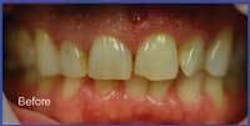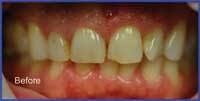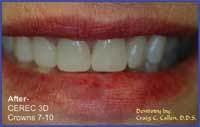Take a second look at CAD/CAM
by Craig C. Callen, DDS
Last week, I had a $10,000 production day without generating a lab bill. Normally on such a day I would have accrued more than $1,000 in lab fees. Why was this day different than most of the others? Well, in addition to some basic operative and endodontic procedures, I prepped and seated six units of CEREC 3D porcelain crowns and onlays on four different patients.
OK, I did have the cost of the Vita and Ivoclar porcelain blocks (about $100 total), but I did not have any impression material or tray costs, so we will say I had a lab expense of about $50. Add to that the payment for the CEREC 3D unit from Sirona ($133 per workday based on an average of 15 workdays per month) for a total cost of about $233.
This is a net savings on lab (and increased profit) for the day of $767. I did not even factor in the fact that my associate produced a couple more units and my savings was even greater. Let me back up a little bit.
Why did I make the leap?
Why did I make the leap now to buy the still rather pricey CEREC 3D?
1) My first concern was the monthly payment of around $2,000 with maintenance fees. But as my consultant, Ken Runkle, president of Paragon Management, pointed out, I was already making the payment; I just did not have the equipment. You see, between my associate and me, we were paying out about $6,000 a month in crown and bridge lab bills and a good portion of that was in single-unit crowns, onlays, and facings.
2) The technology has improved significantly with the 3D software. The design and mill time have been greatly reduced and the quality of the restorations has improved. If you haven’t seen what CEREC can do lately, you haven’t really seen what CEREC can do. Gone are the days of average esthetics and design. You will be amazed at how well the fit on these restorations can be as well as the improved porcelains. They are easy to adjust and polish. Have you ever thought about all the possibilities for distortion with a typical crown? The impression could distort, the model could be off, the impression endures heat and cold when shipping, there is a spacer placed, the bite registration or mounting could be off. If you really think about it, it is surprising our crowns ever fit right due to all the possibilities for error. With the CEREC 3D system, you take a direct scan of the tooth with minimal chance for distortion or error. The biogeneric occlusion software that just came out will amaze you with its accuracy.
3) The choice of materials has improved. Not only are the porcelain and composite choices strong, but they also come in a huge variety of colors and opacities. There are even blocks that have varying translucencies from incisal to gingival. The choice of different cement shades, along with the chameleon effect of the porcelain, makes for some beautiful restorations. The new Empress blocks are as lifelike as possible and do not wear the opposing teeth like some lab porcelains. If necessary, you can do some quick staining and glazing to customize the shade. I find it easier to do internal staining, which does not require an oven and will not wear off over time.
4) The fabrication procedure can mostly be delegated. The dentist can prep the tooth and the staff can capture the images, design the restoration, and try it in before final cementation. With proper design, there is minimal adjustment.
5) Patients love it. This is impressive technology, and patients are amazed. We take time to show them what we are doing, including the milling process. Before-and-after pictures allow patients to show their friends what you did for them. Patients also save a second appointment and all of the hassles that go along with wearing a temporary.
6) There is a time savings for the office. By delegating the design and fabrication stage, I spend about the same amount of time as I used to on the preparation stage, but my seat time is usually less due to the accuracy of the fit. We also save time scheduling and confirming a second appointment and setting up and cleaning a room for that appointment. Then there are the 10 percent of patients who miss their seating appointment. Add to that the time for recementation of temporaries and you start to see the difference.
7) We are doing fewer big composites now and more inlays and onlays. One of the biggest problems with inlays and onlays used to be temporization. They either tended to fall out due to lack of retention, or we had to lock them into the category called “We are more likely to recommend replacing the ugly DO amalgam next to the crown preparation because I know I can easily produce a beautiful, strong restoration.” The properly bonded CEREC restoration will bring the tooth back to full strength as opposed to composites that tend to weaken it.
8) We still work with the local lab. For anterior cases, we can pay a flat fee to the lab to come to the office and custom stain the case. The lab also provides diagnostic wax-ups of cases that can be used in the final design. We also have the option of scanning the preparations and sending them to the lab for custom fabrication.
9) There is a huge support network in place for CEREC users. There are a bunch of doctors out there who have already suffered through primitive software programs and who are now providing training to other dentists in the form of DVDs, manuals, seminars, and in-office training. There are Internet groups and societies available for doctors who want to improve their skills. Patterson, the U.S. distributor for the CEREC 3D, offers a monthly service contract to keep you up and running for a low monthly fee.
10) The preparation designs are fast and easy. With depth cutting burs and specially shaped burs, preparations have become a no-brainer. You are basically concerned with removing decay, having adequate clearance, and the shape. Meanwhile, you are less concerned about designing for retention because you are bonding the porcelain in place. You can be more conservative and use supragingival designs.
A laser for tissue troughing makes the process even faster. Most of my preparations are finished faster than they used to be. With root canal teeth, I can even incorporate my post into my restoration.
11) Using the CEREC 3D is making me a better dentist. I either trace all of my own margins on the computer enlarged 30 times (which is humbling to see), or check the assistant after he or she has marked the margins.
I now have a better appreciation of what the lab has to deal with, so I work harder to obtain clear margins and adequate reduction. I am also placing more of the stronger and more esthetic porcelain inlays and onlays.
Downsides?
Are there any downsides? One would be the cost hurdle, which I am sure will come down in time, but is still cost-effective now. There is also a learning curve that takes some dedication to overcome. The mechanics of our scheduling have changed and are sometimes more challenging at first.
With patience and perserverance, you, too, will become a CEREC 3D convert. Now you can provide a cost-effective, esthetically pleasing restoration in a timely and time-saving manner. As I said at the beginning of the article, if you haven't seen CEREC lately, you haven't seen CEREC. You need tot take another look.
Dr. Craig Callen is a full-time practicing dentist in Mansfield, Ohio. He is the associate editor of "The Profitable Dentist" newsletter and lectures on clinical and practice-management topics. Dr. Callen and his wife, Dee, have five children. He can be reached at (419) 756-0188 or [email protected]



